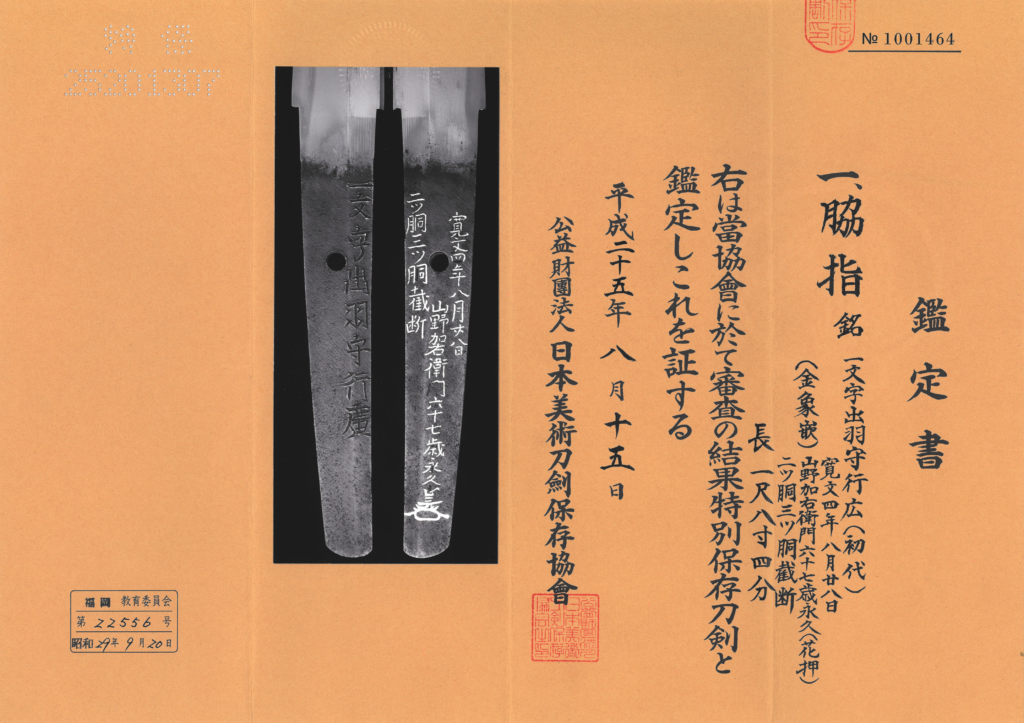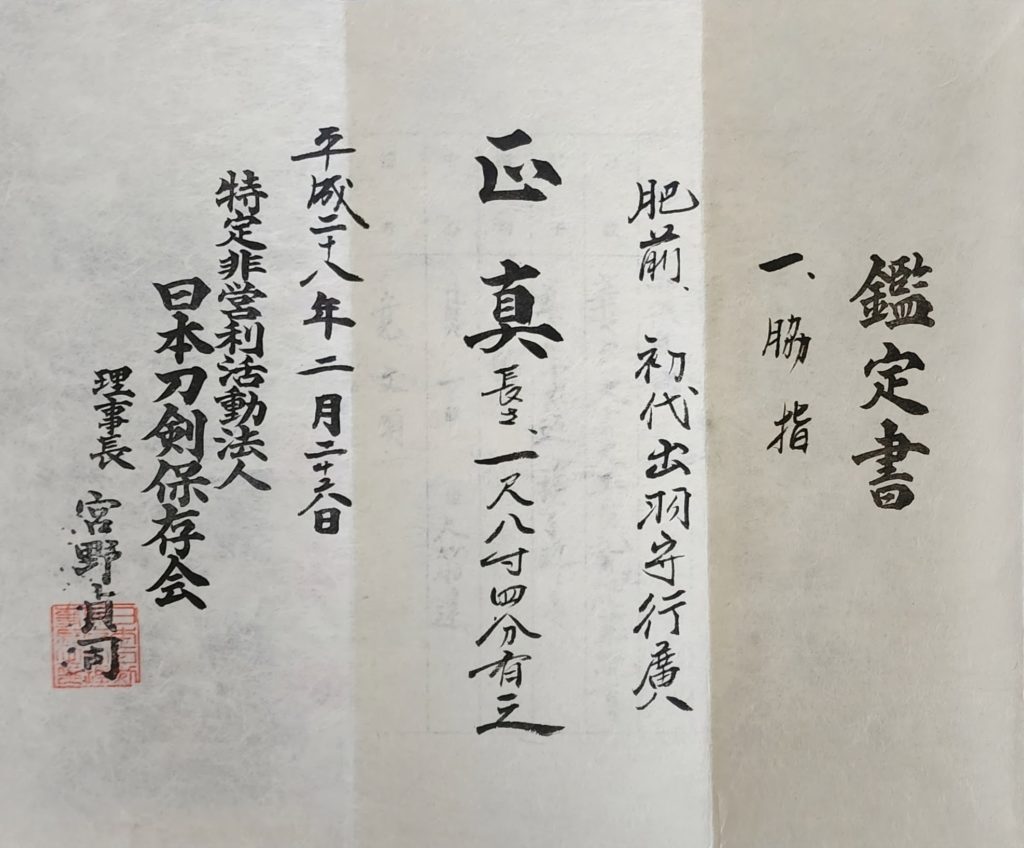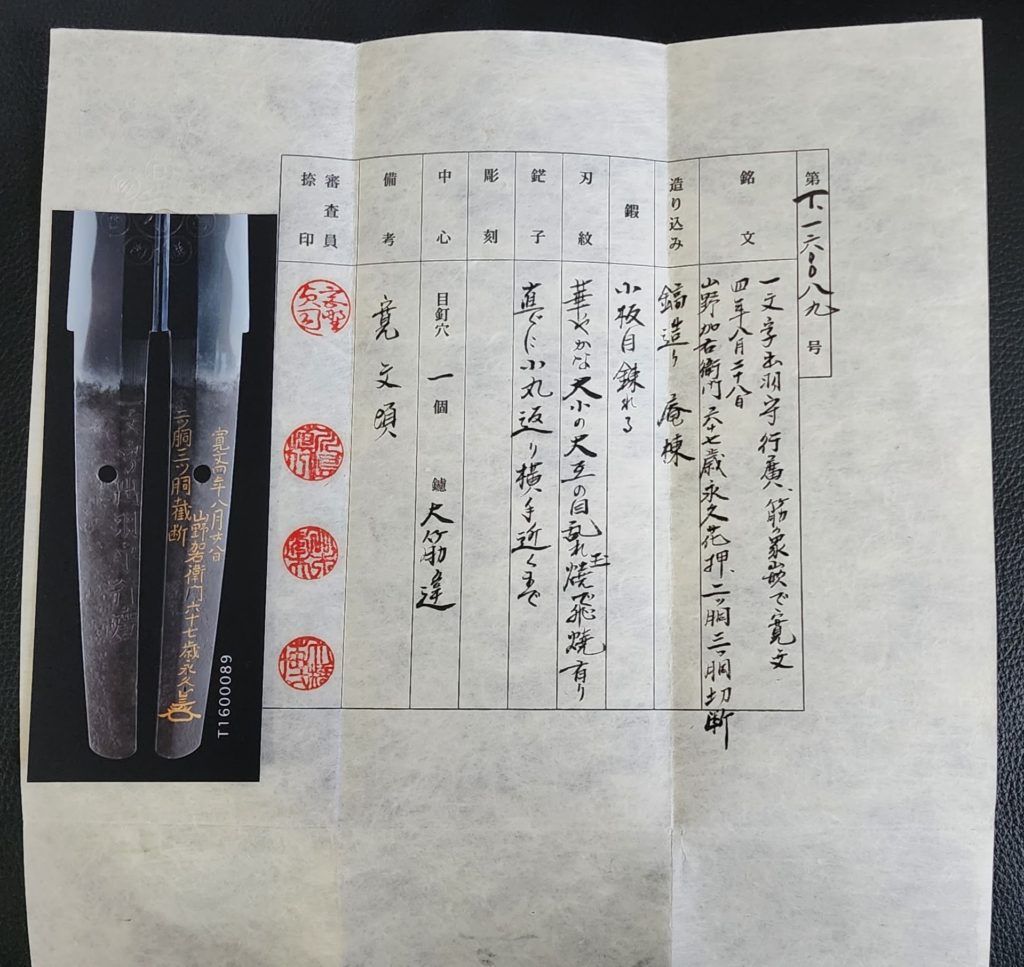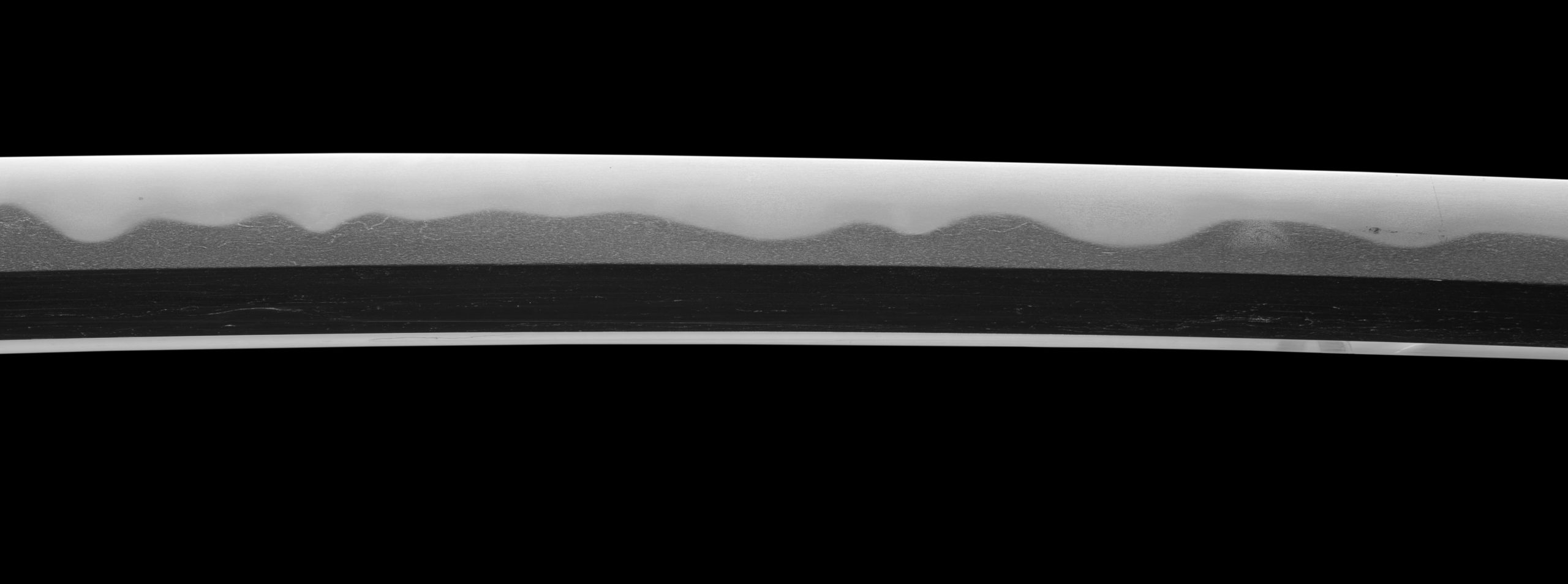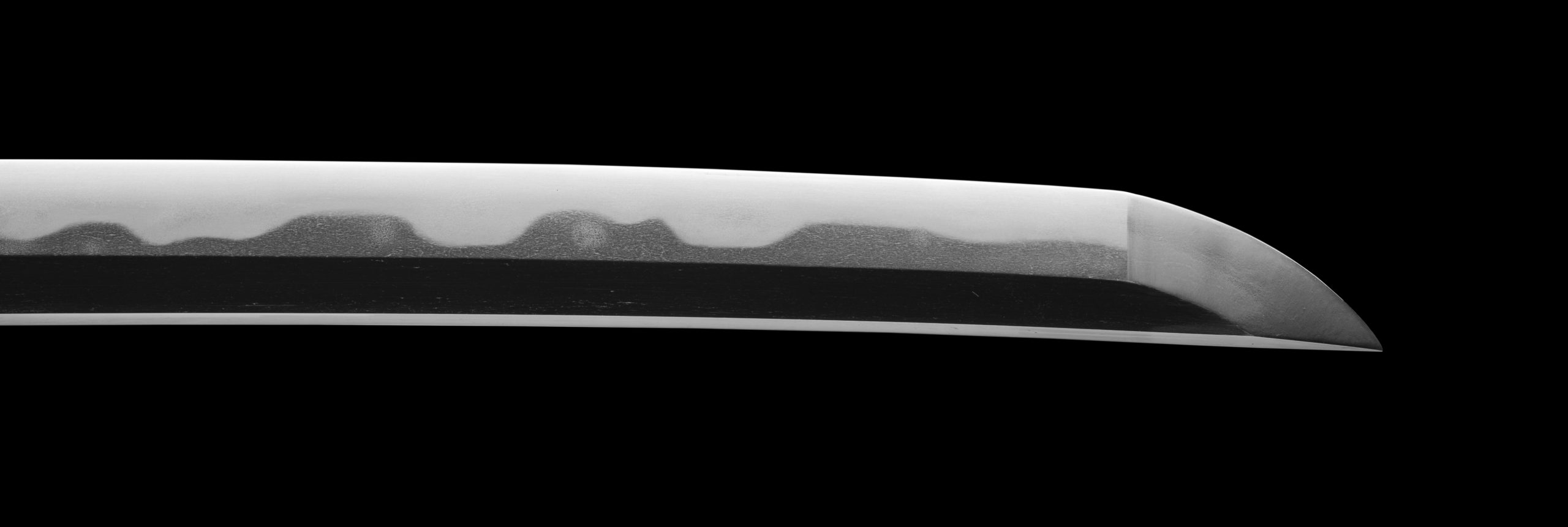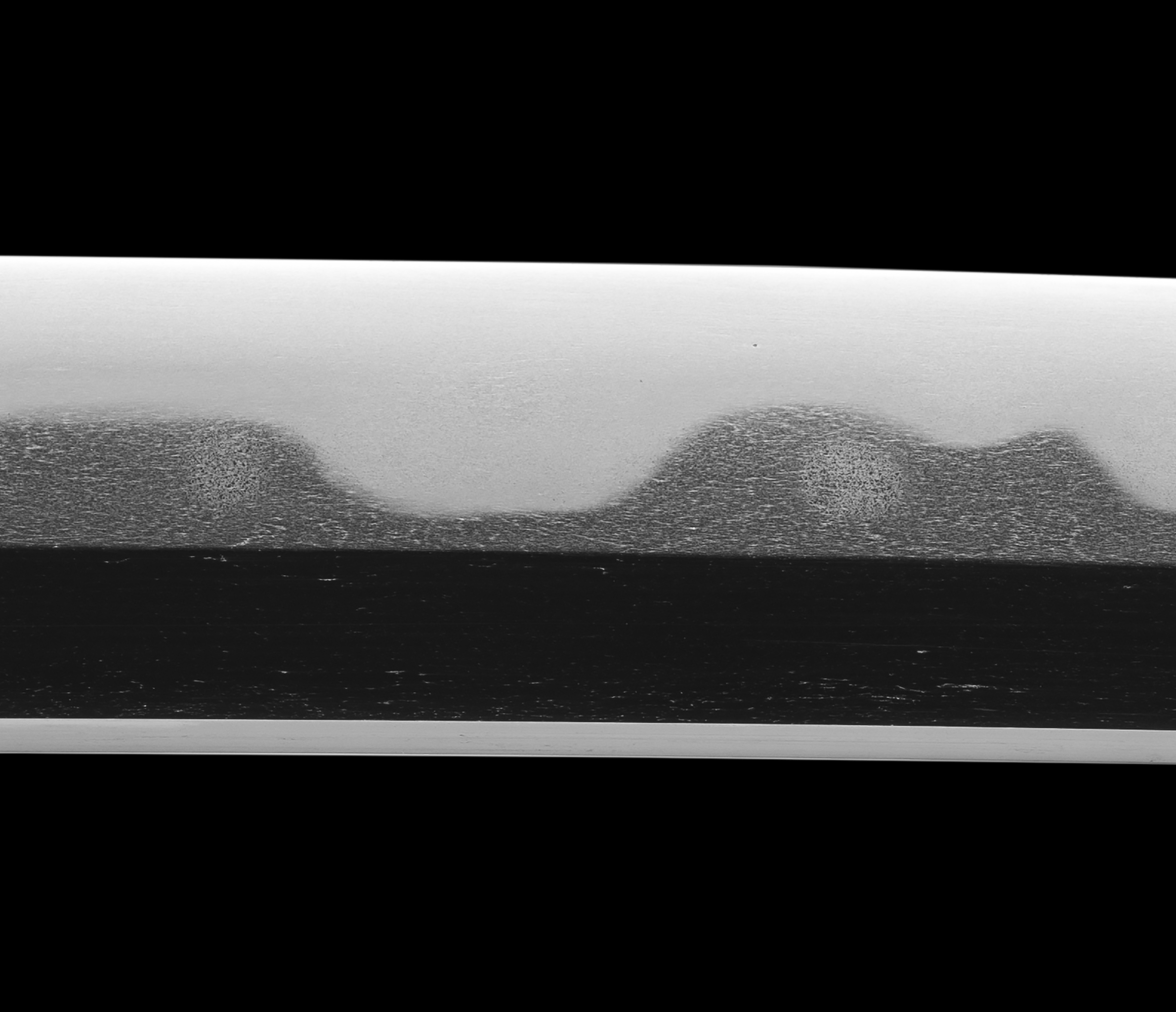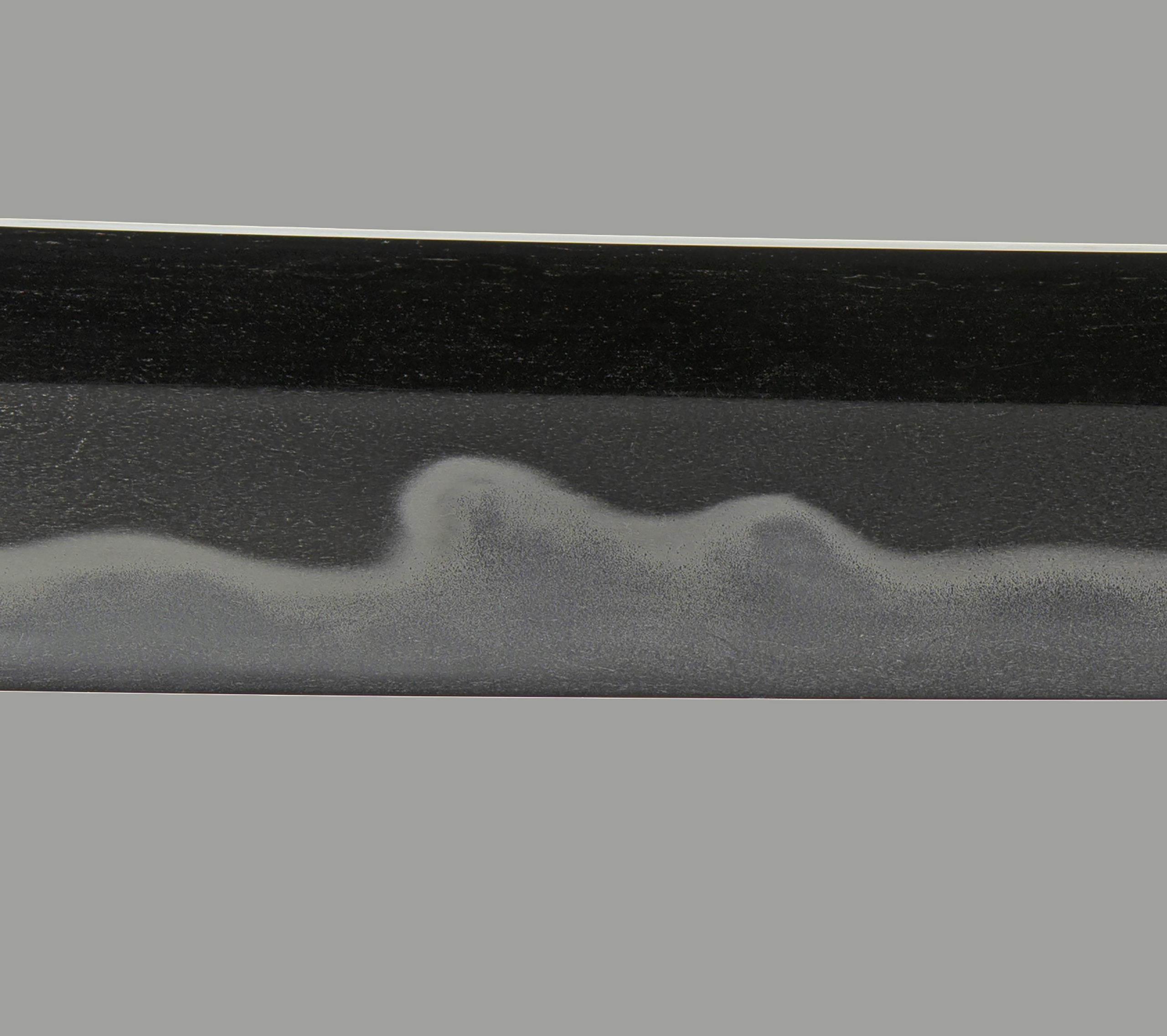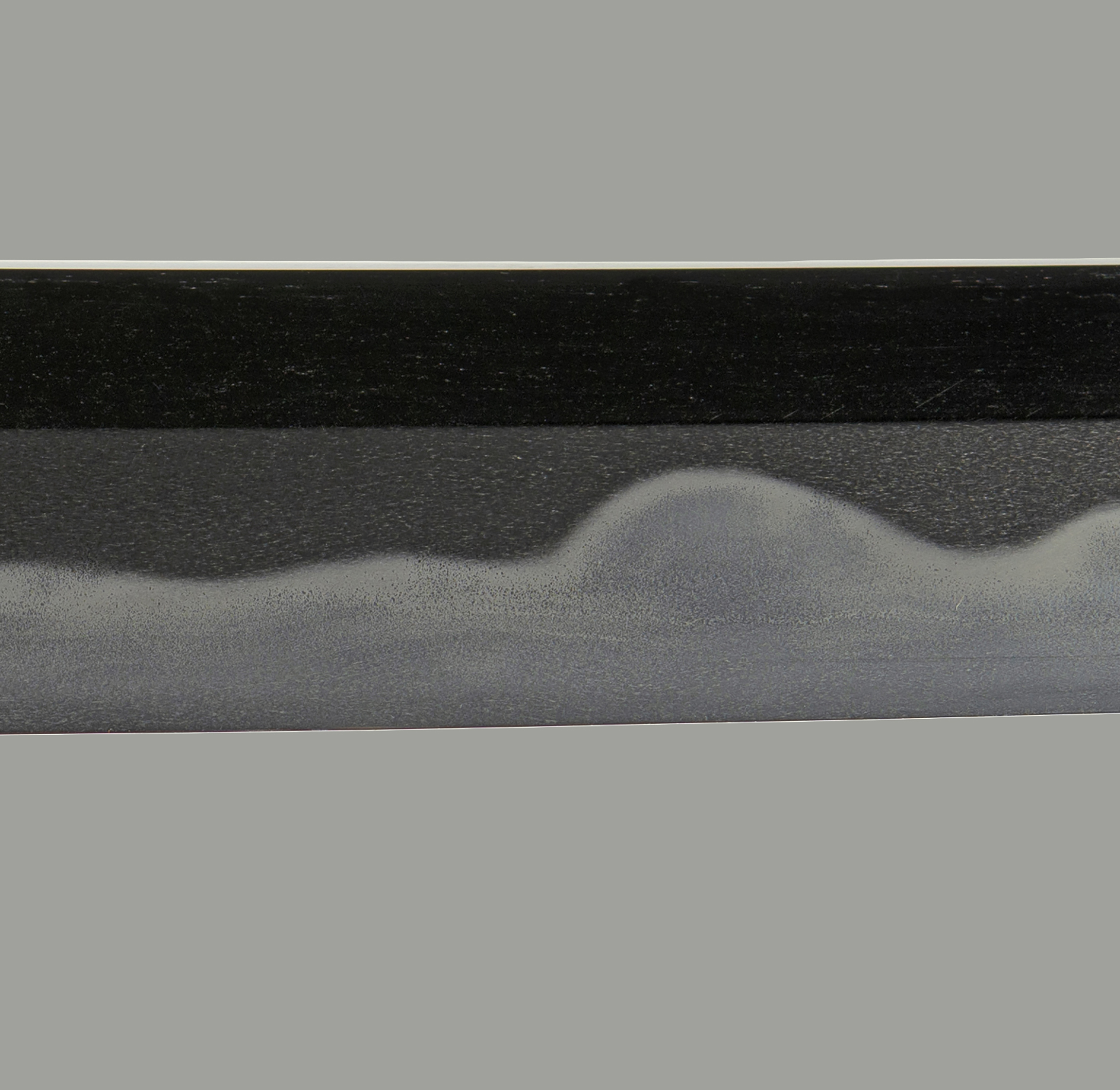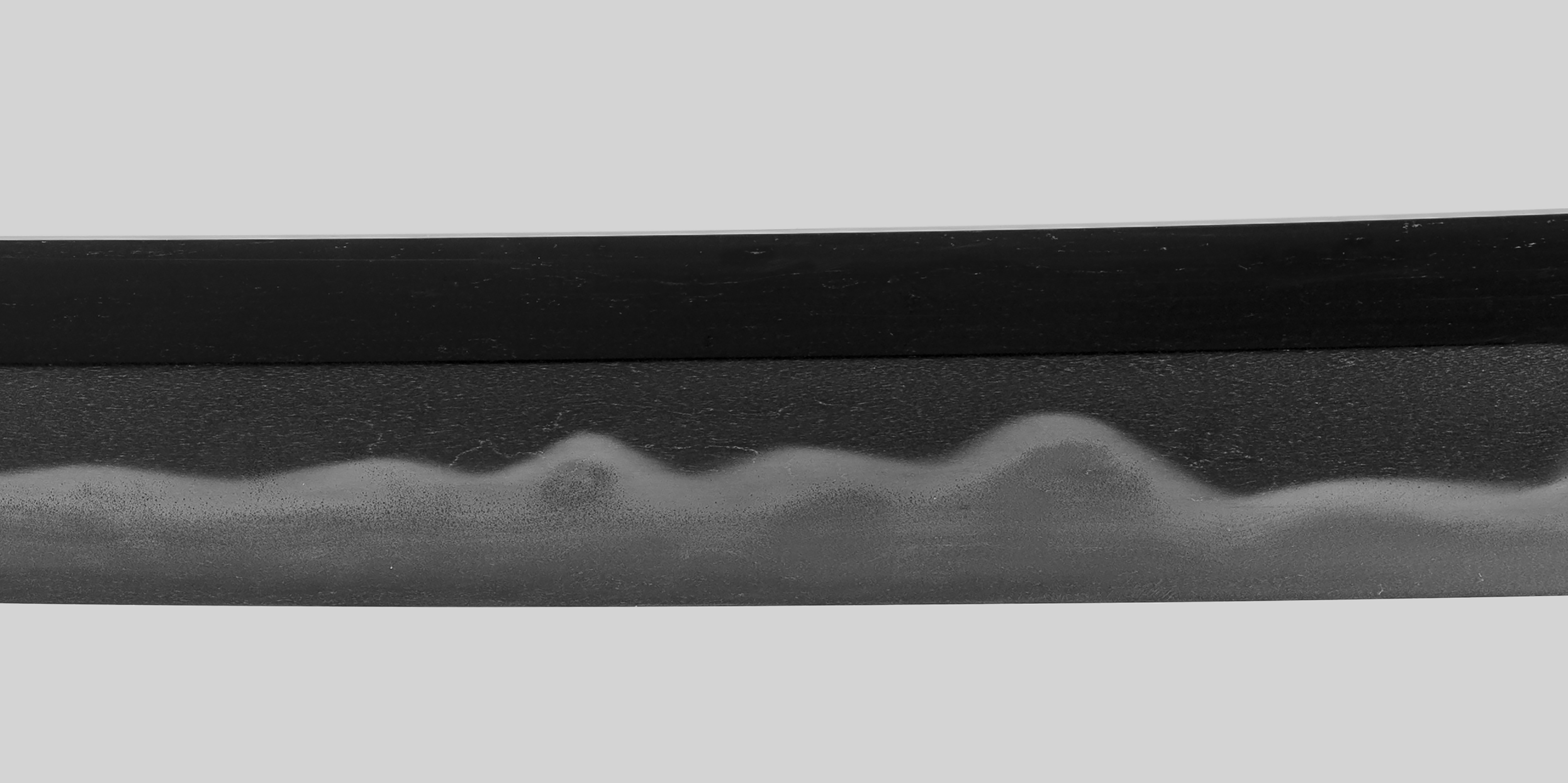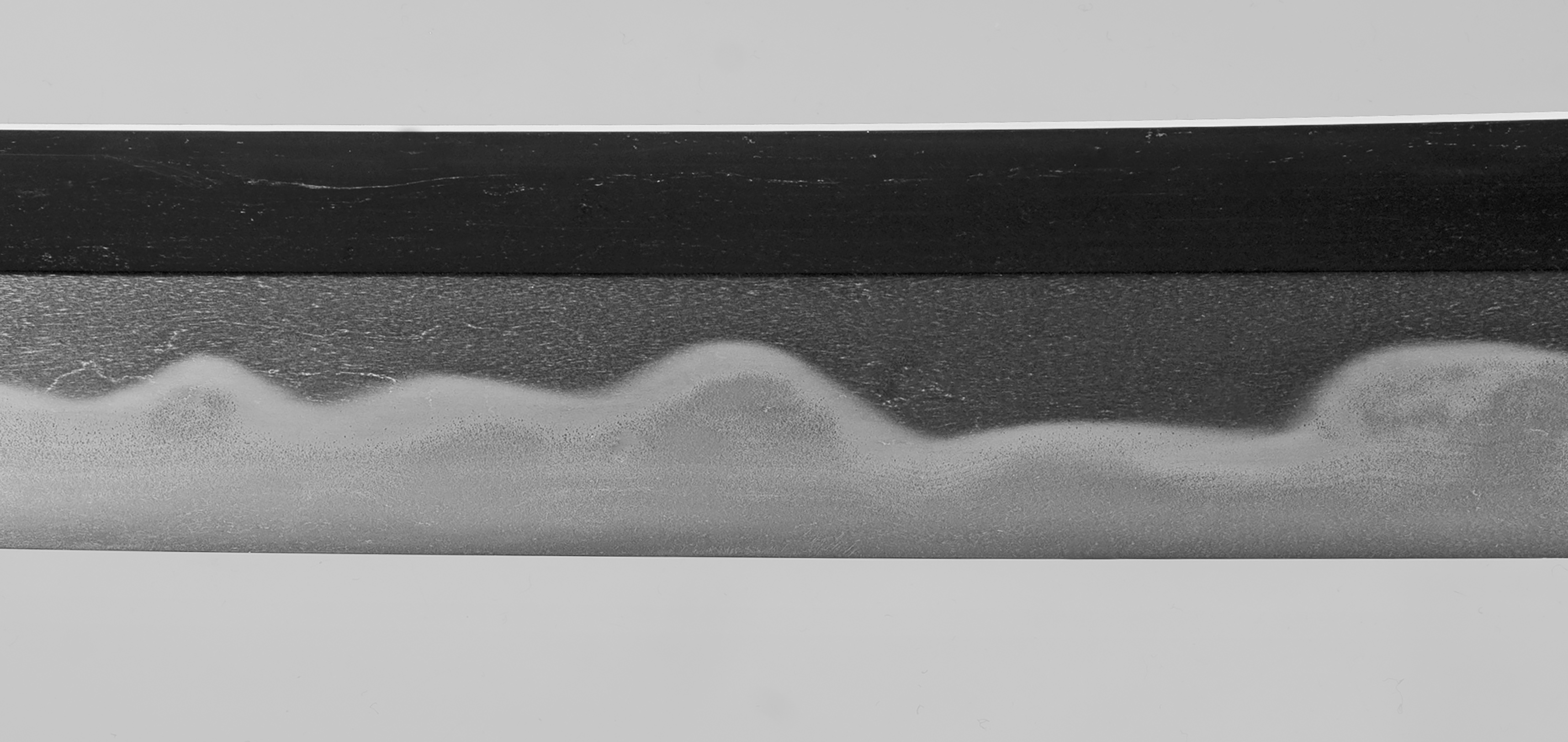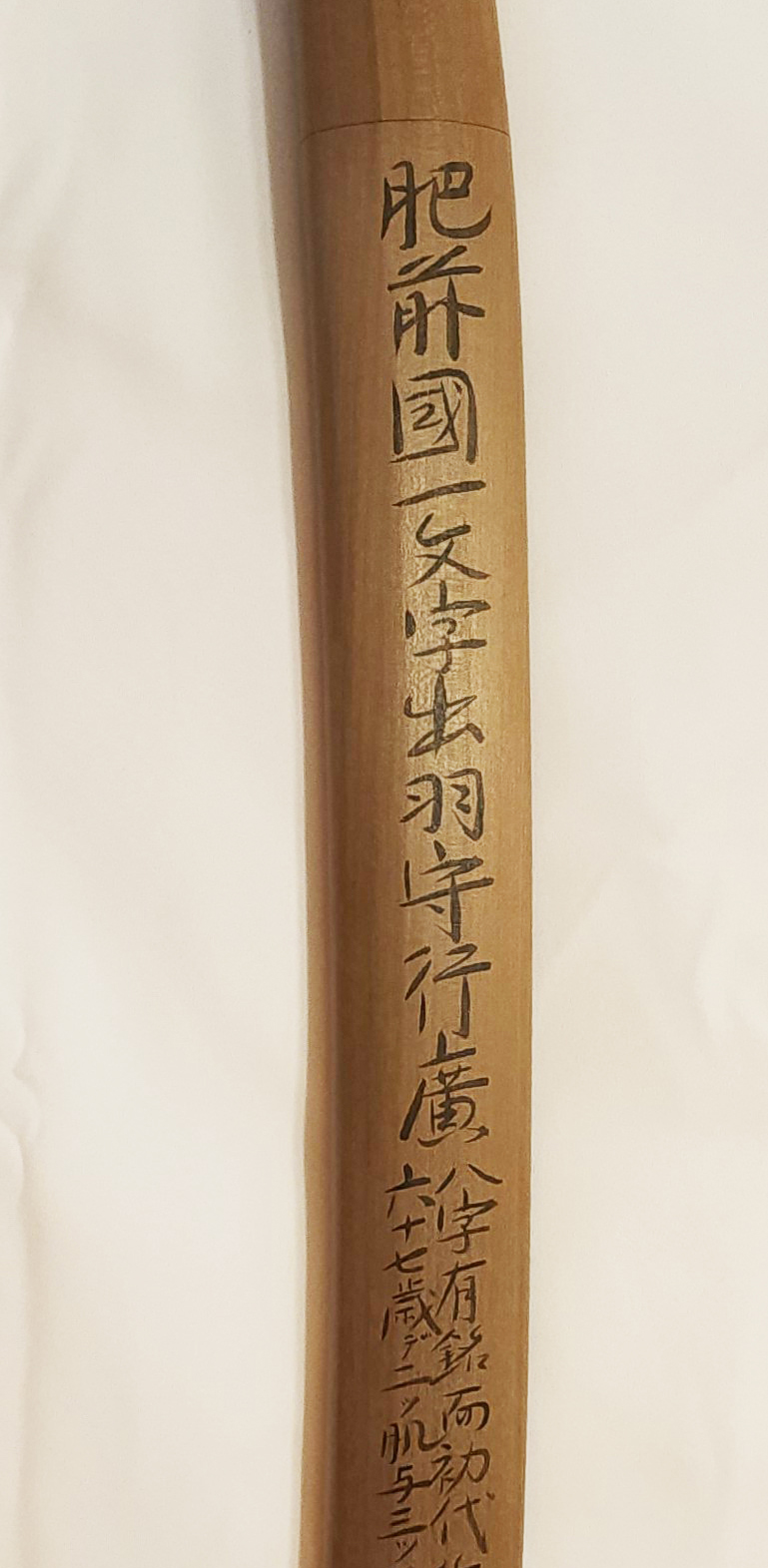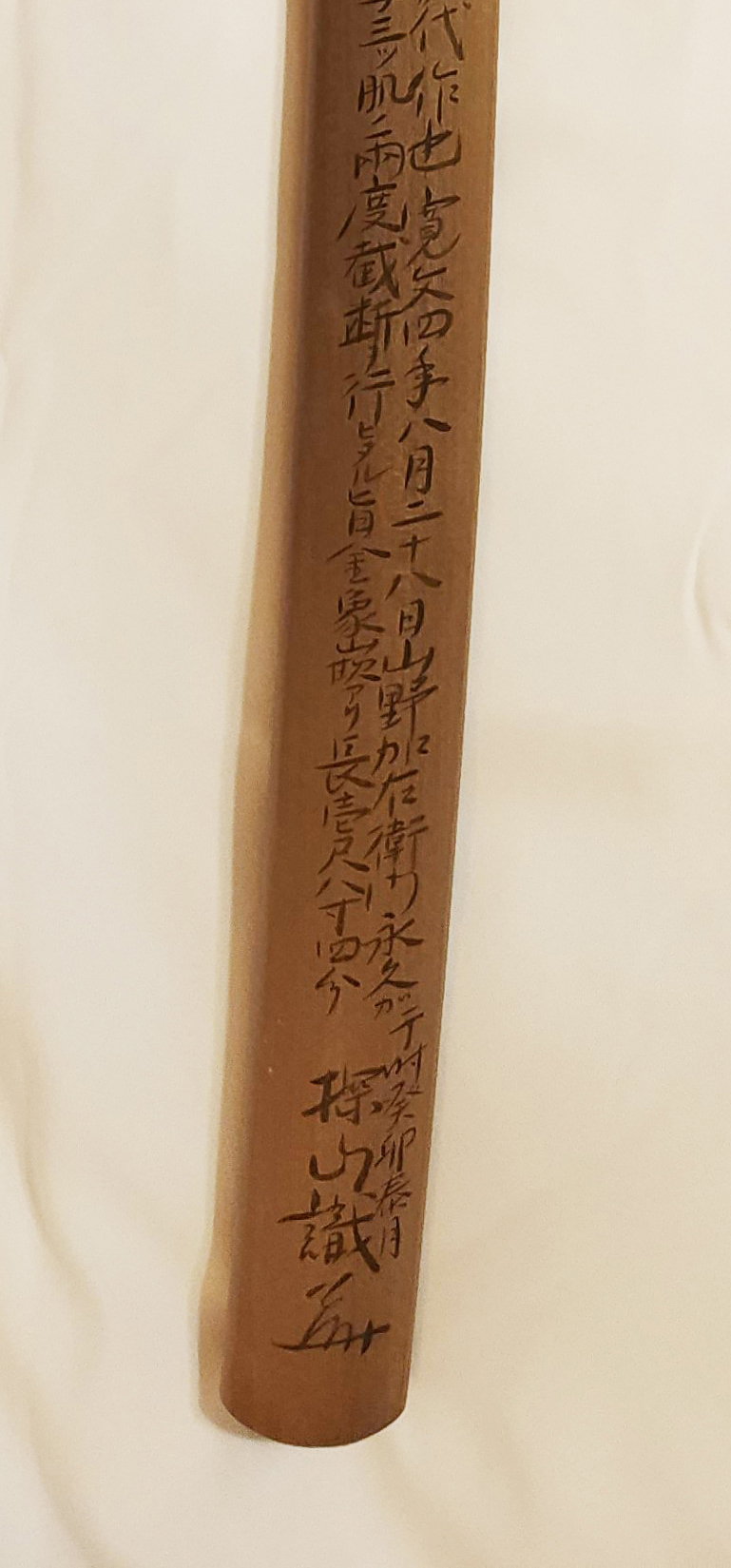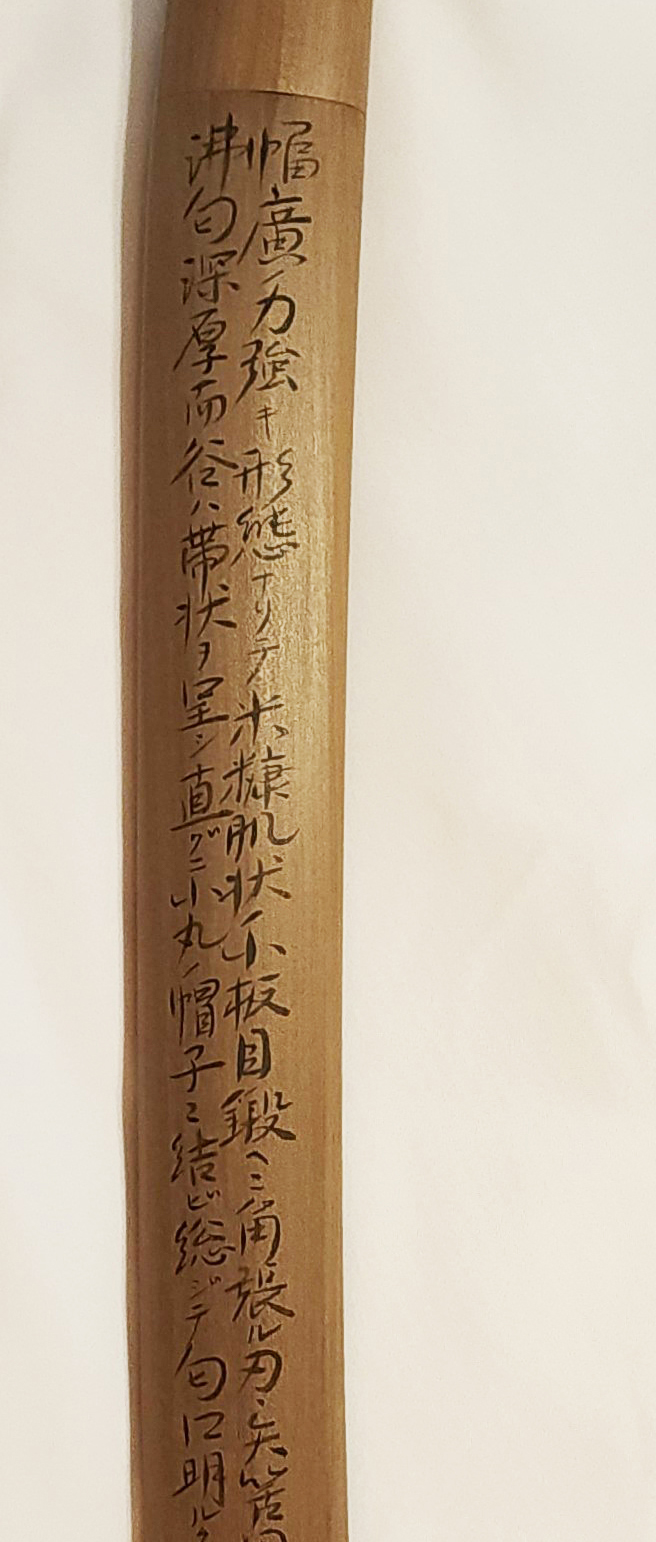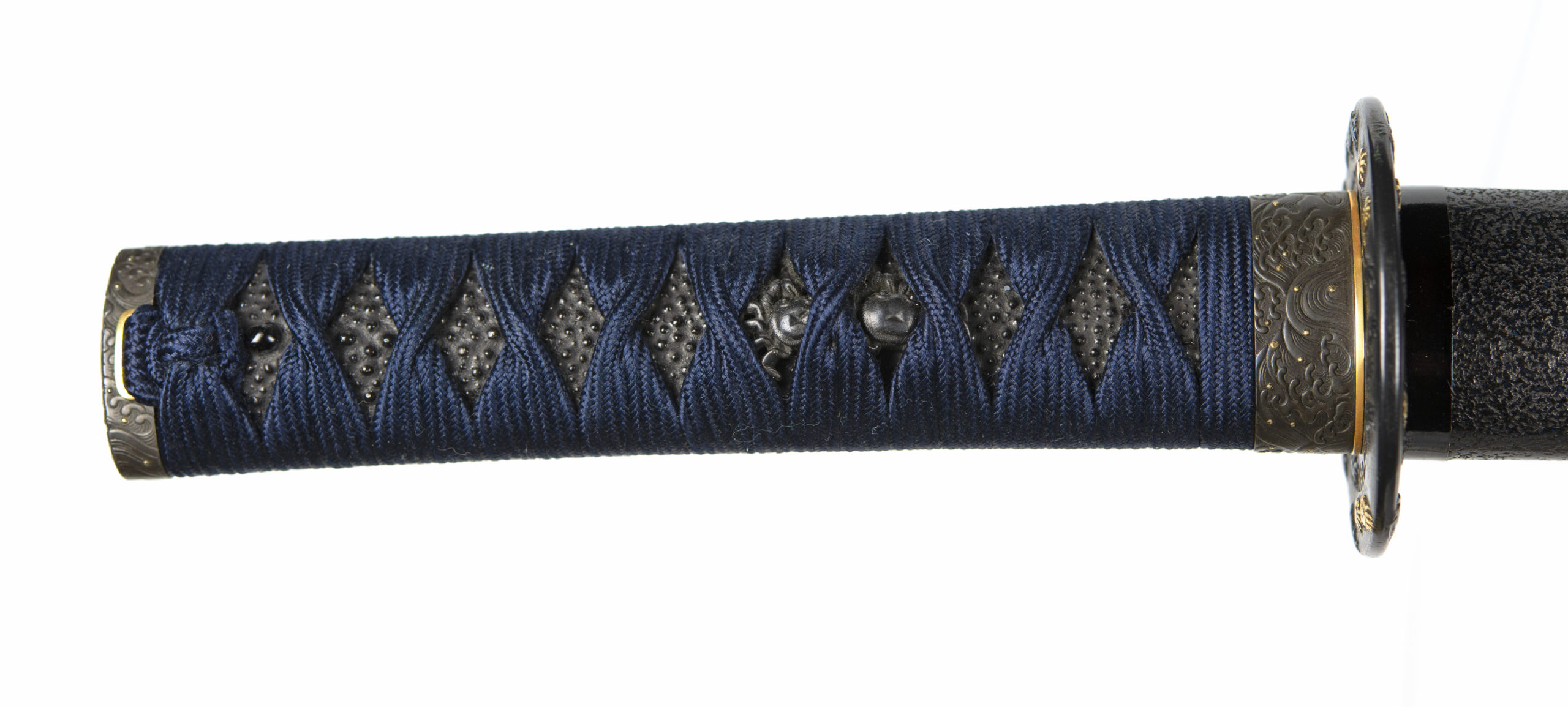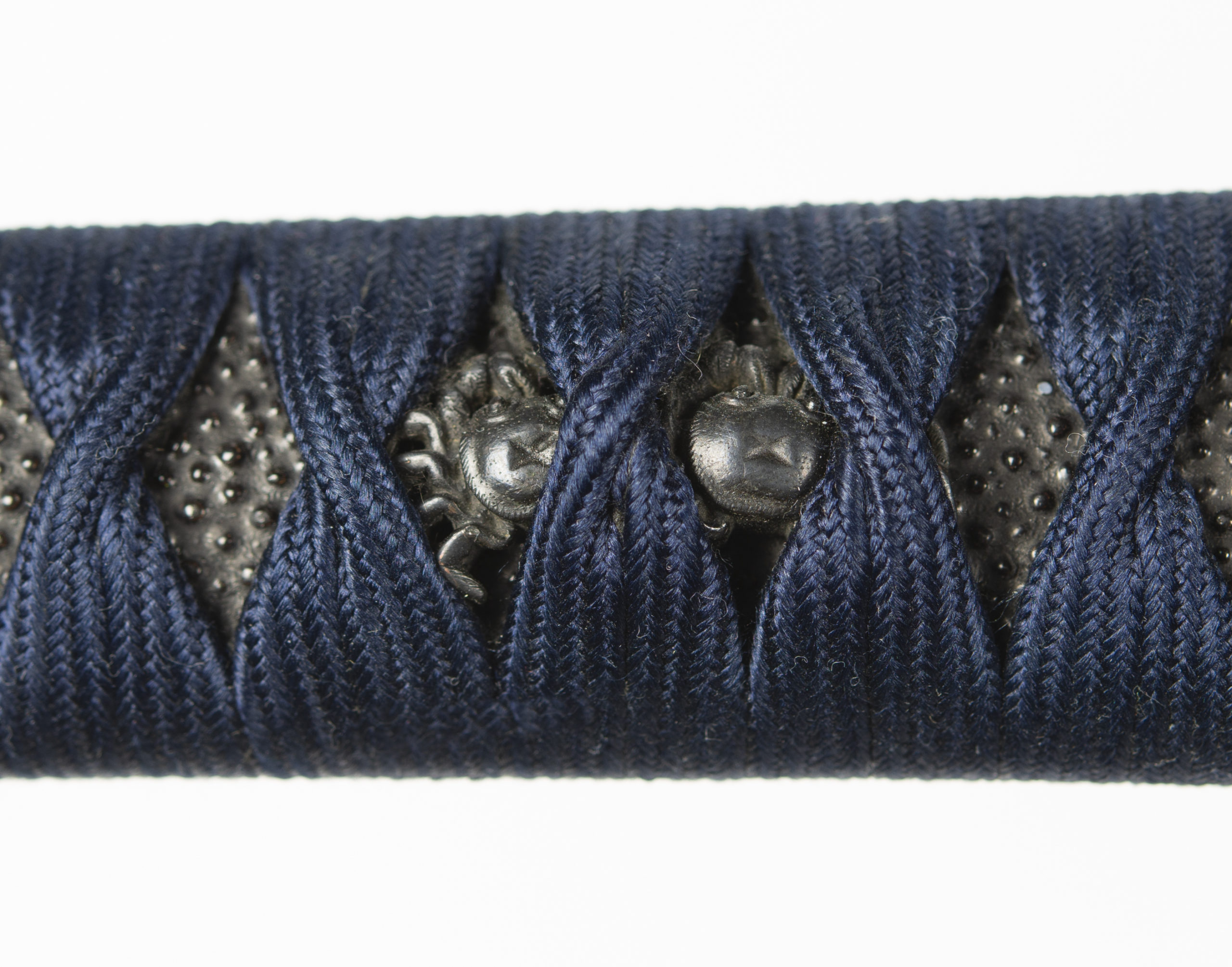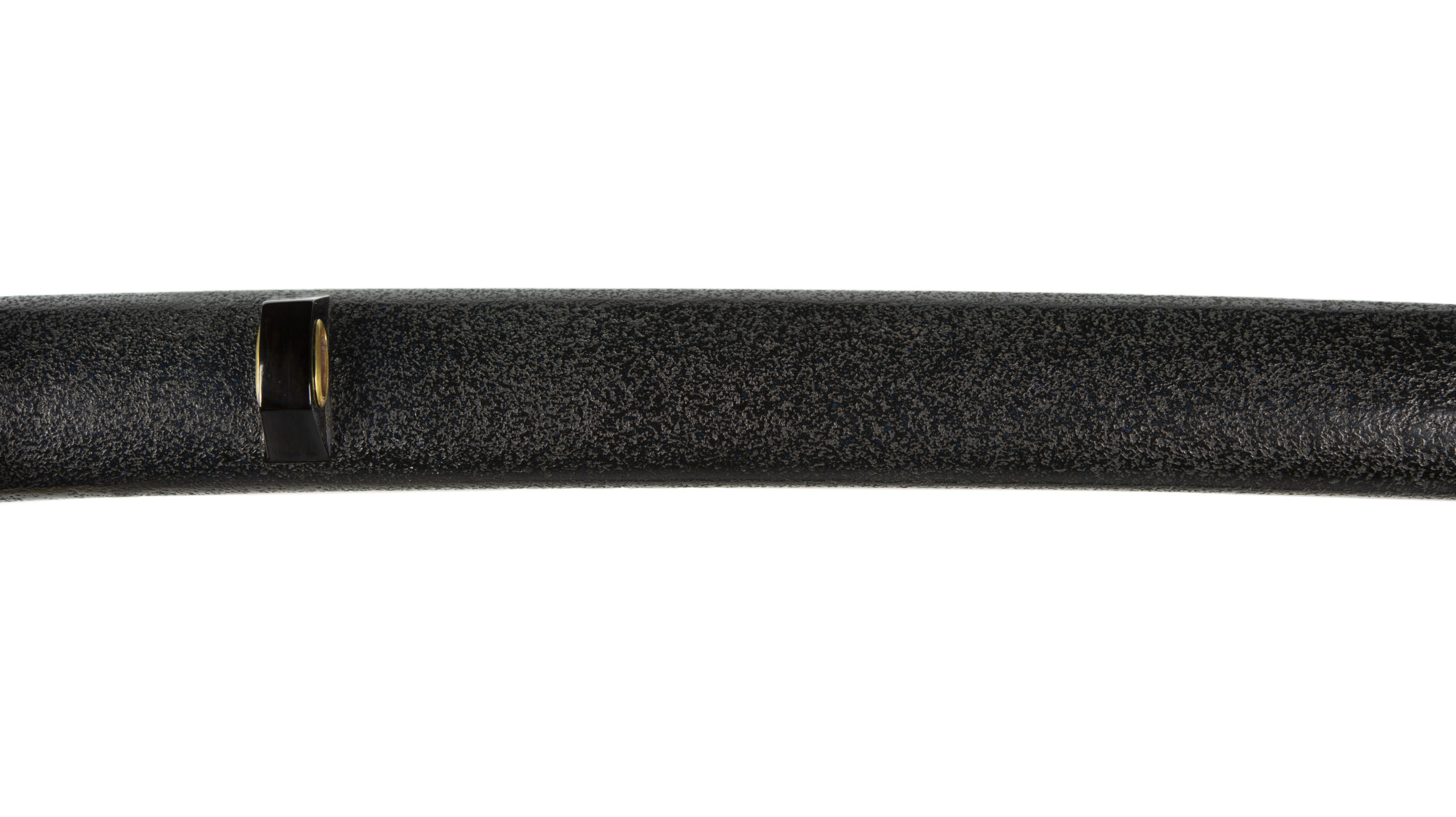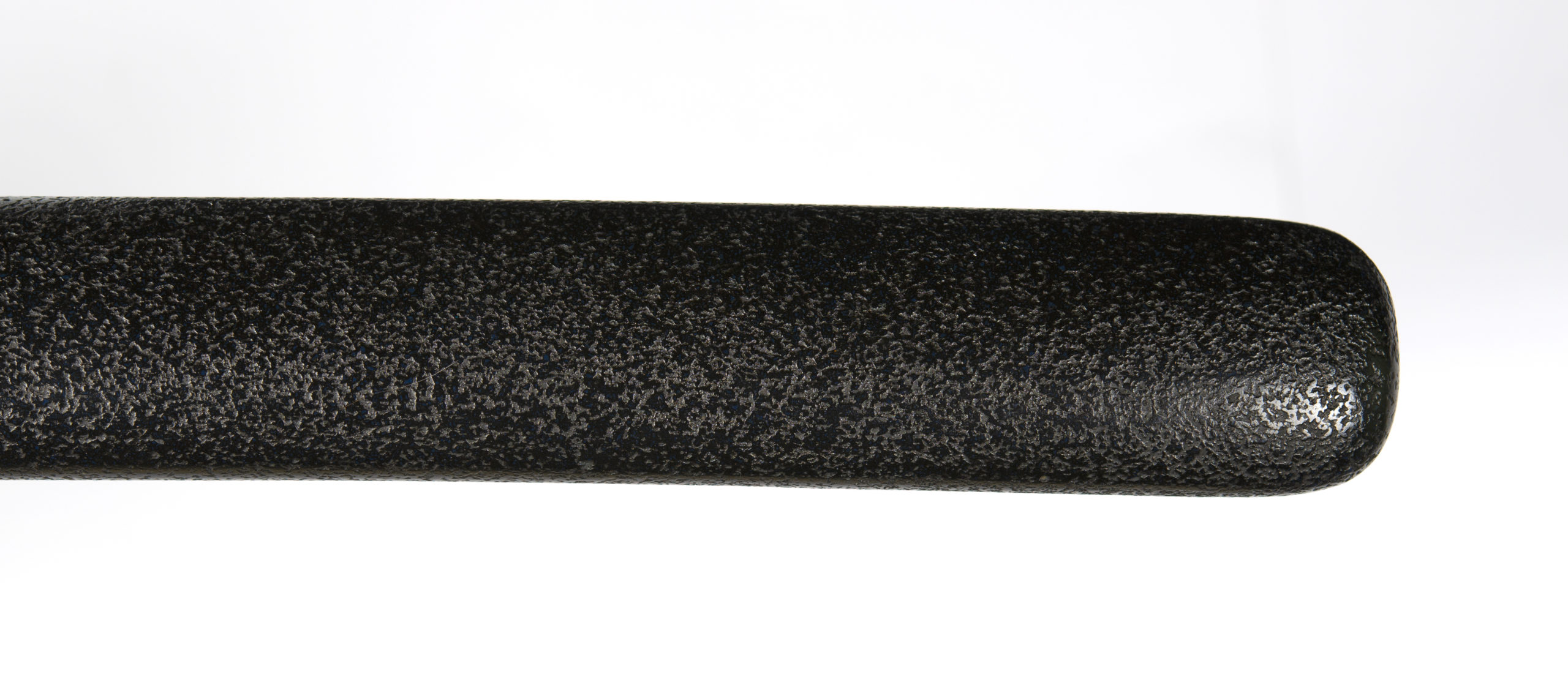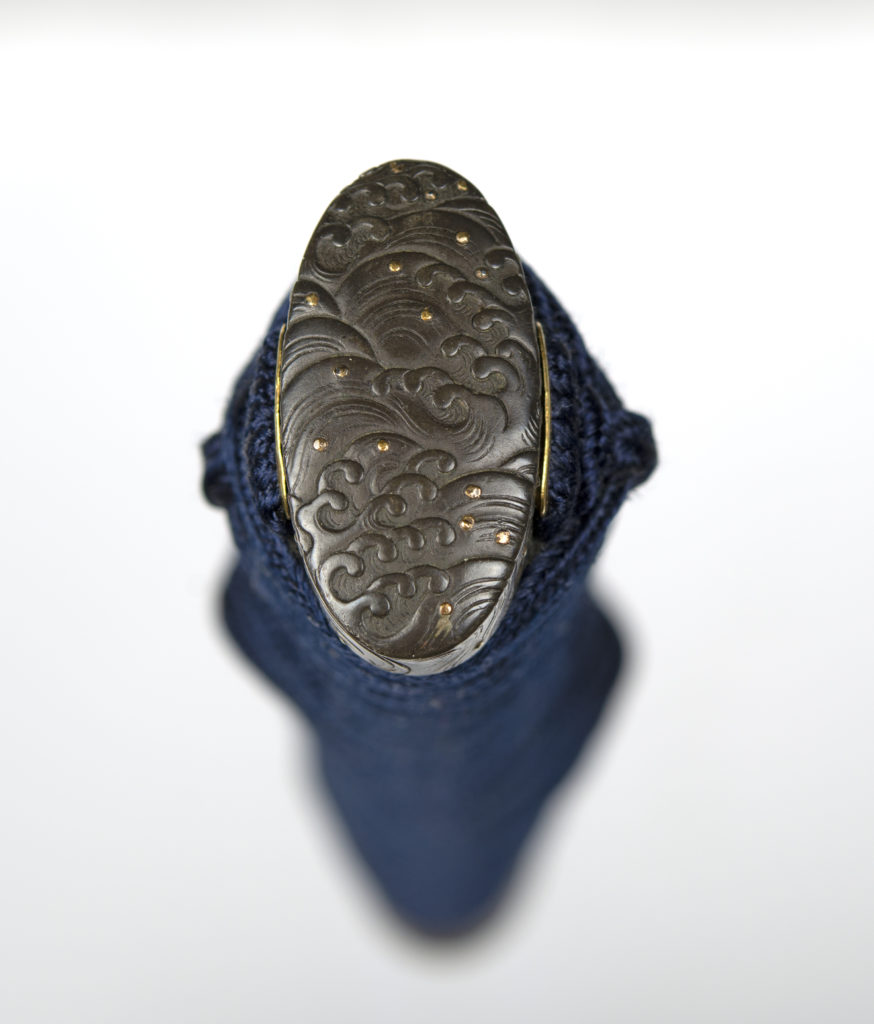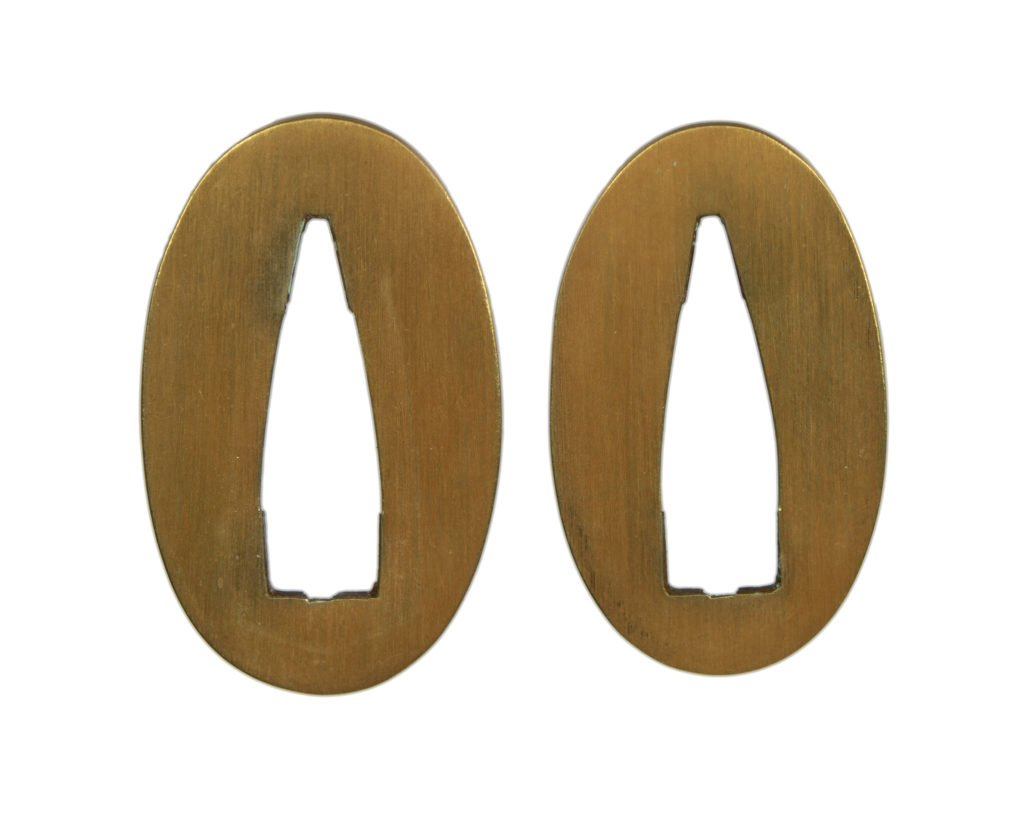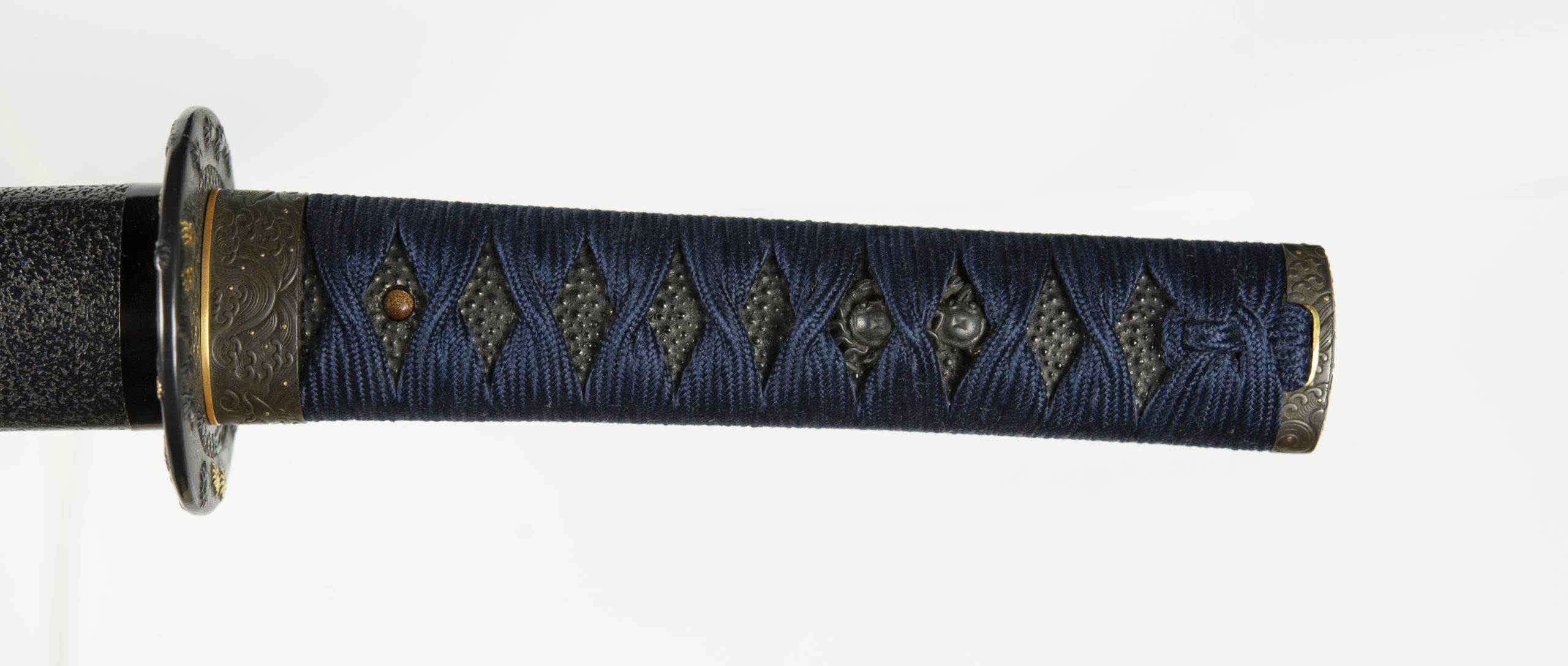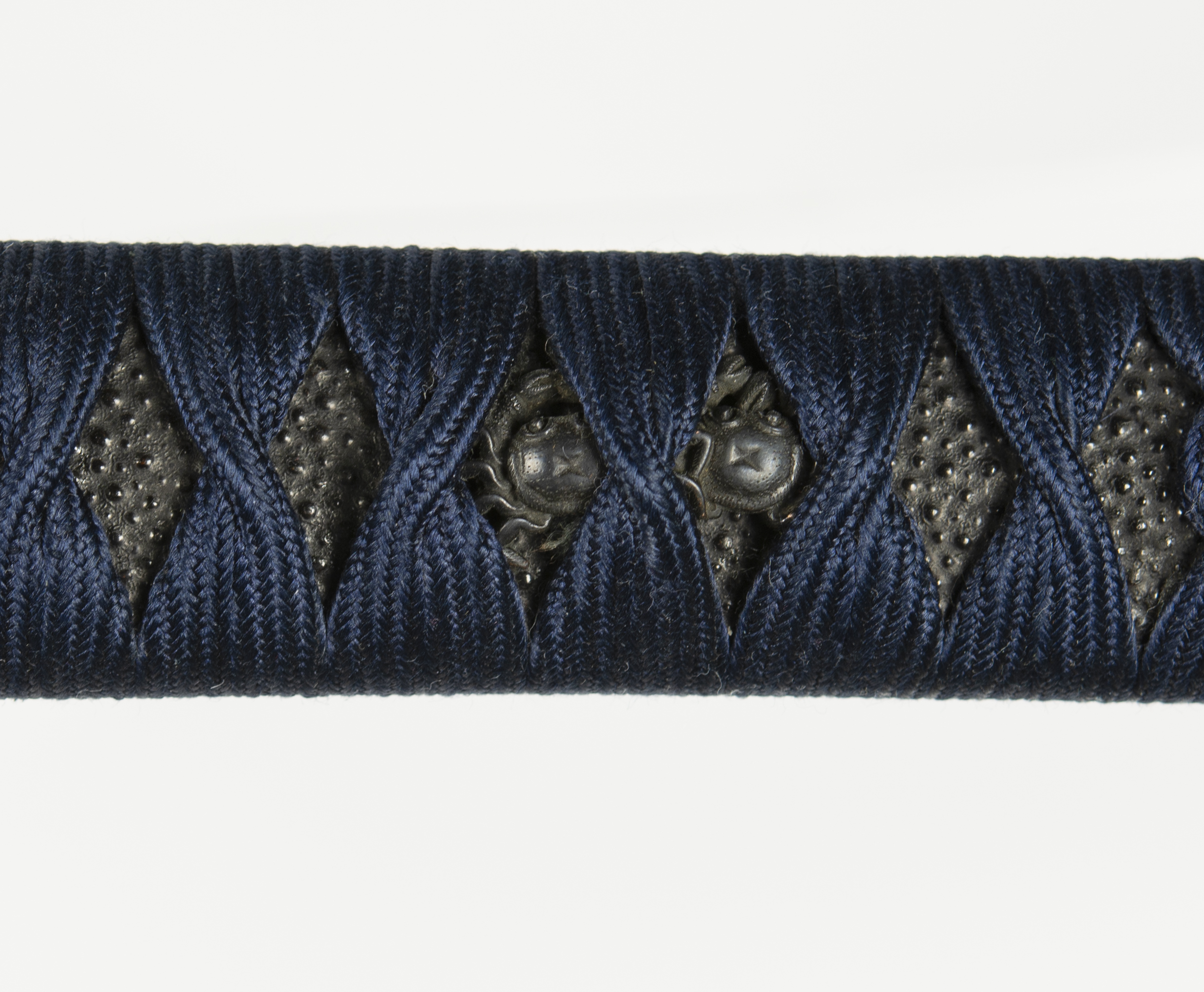See additional detail of full koshirae at the end.
Description
This is a fine wakizashi by 1st Generation (shodai) Yukihiro, born 1617 from Hizen province. Hizen province, located on the Island of Kyushu, was home to some of the most skilled and famous swordsmiths active in the Shinto period (1596-1764). Hizen swords were highly sought after due to their supreme cutting ability, balance, and durability. His first known sword was made in Kan’ei 1639 at the age of 22. He was given the title “Dewa Daijo” in 1648 then later granted the title “Dewa (no) Kami” in 1663. During the Keian 3rd (1650) he traveled to Nagasaki to study Dutch forging techniques under Yakushiji Tanenage & Hisatsugu.It is said he studied the Bizen Ichimonji techniques under Noriyoshi. This blade bears the Ichi (Ichimonji) character.
This is signed – Ichimonji Dewa no Kami Yukihiro (????????)). A wakizashi measuring at 55.7 cm nagasa [cutting edge]. Made in kanbun which ranges from 1661-1673 AD with a 2 & 3 body gold inlay cutting test done by Nagahisa August 28th, 1664, also to include a custom koshirae. We can conclude with his new title received in 1663 and date of cutting test in 1664 that this wakizashi was made in 1663 or 1664.
The blade is now stored in a new 20+ year old aged honoki, with sayagaki by Tanzan, Tanobe Michihiro sensei. The prior shirasaya (for the last 50-75 years or so) has sayagaki by ?? (Kens?), otherwise known as Murakami K?suke, a prior board member and shinsa judge of the NBTHK, now mounted on a wooden blade (tsunagi) for preservation.
Yukihiro has an NBTHK Tokubetsu-hozon certificate, meaning Extraordinarily Worthy of Preservation . The fuchigashira, menuki and tsuba each have NBTHK Hozon certificates meaning Worthy of Preservation . There is also a 5th certificate on the blade by NTHK-NPO at the 2016 Chicago shinsa of which it scored a 78 of 100 (see scan of worksheet) , during the prior ownership.
Tanobe Michihiro sensei (former Senior manager of the NBTHK’s Japanese sword museum) wrote with his sayagaki a description of this sword in his eyes.
“This blade has a wide mihaba and is of a powerful shape. It displays a kitae in ko-itame that appears as konuka-hada and is hardened in long intervals in angular and yahazu elements and ch?ji , that are connected via gently undulating notare sections. The ha is nie -laden and the nioiguchi is wide and appears in the typical belt shape in the valleys of the ha . In addition, the b?shi is sugu with a ko-maru-kaeri , and with the nioiguchi being bright and clear, we have here a textbook work by this smith, which is also of an excellent deki .”
At the end of Yukihiro’s career, he was serving under Nabeshima Sakyo in the town of Nagase, he passed away at the age of 66 May 27th, 1683 (Tenna 3rd). His line continued into later generations as far as the 1900’s.
In his family ranks were Shodai Hizen Masahiro (his older brother by approx 11 years), his father Yoshinobu (adopted), and his grandfather Shodai Hizen Tadayoshi. Yukihiro was known to sign his katana with tachi-mei, and his wakizashi with katana-mei (sashi-omote).
The blade was registered on September 20, 1954, in Fukuoka under the register number 22556.
Ratings:
Fujishiro’s reference: Jo Saku (Superior made)
Hawley’s:90 points
Sharpness rating:Kokan Kaji Biko by Yamada Asaemon- rated as Wazamono (High degree of sharpness).
Toko taikan:5.5 million Yen
Certificates: Blade- original NBTHK certificate, NBTHK Tokubetsu Hozon & NTHK-NPO, Fittings – NBTHK Hozon 3x.
This Sword is available for purchase. With serious interest please inquire for pricevia email or contact us at 1(608) 315-0083 telephone or WhatsApp.
Please continue to view below.
Thank you.
Signature (mei) Translation
Signature (mei) Translation :
Ichimonji Dewa No Kami Yuki Hiro
Translation of Kinzogan mei:
Yamano (Family name) Kauemon (his first name of cutter), 67 Sai (67 age) Naga Hisa (given name) Kao
Kanbun 4 year (1664) Hachigatsu (August) 28 Nichi (date of 28th)
Futatsu Dou (two body) Mitsu Dou (three body) Sai Dan (cut)
Sayagaki by Kens?. Kosuke Murakami was formerly on the board of directors with the NBTHK. In the 1980's he issued his own papers under T?ensha.
???????????
???????????????????????????
??????????
??????
Hizen no Kuni Ichimonji Dewa no Kami Yukihiro
Hach? isshaku hassun yon-bu go-rin kore ari, tadashi Kanbun yonen Yamano setsudan kinz?gan-mei hairu nari.
Sh?wa yonj?rokunen yayoi ch?kan
Kens? + ka?
Ichimonji Dewa no Kami Yukihiro from Hizen Province
Blade length ~ 55.8 cm, bears a gold-inlaid result of a Yamano cutting test performed in Kanbun four (1664).
Mid-third of March of Sh?wa 46 (1971)
Kens? + monogram.
Sayagaki by Tanzan, Tanobe Michihiro sensei (former Senior Managing Director) of The Japanese Sword Museum at the NBTHK.
???????????
?????????????????????????????????????????????????????
???????
?????????????
??????????????????????????????????????????????????????????????????????????????????????????????????????????
Hizen no Kuni Ichimonji Dewa no Kami Yukihiro
Hachi-ji y?mei shikamo Shodai saku nari. Kanbun yonen hachigatsu nij?hachinichi Yamano Ka’emon Nagahisa ga rokuj?nana-sai de futatsu-d? yo mitsu-d? setsudan o okonai-taru mune kinz?gan ari.
Nagasa isshaku hassun yon-bu
Toki ni mizunoe-u taigetsu Tanzan shirusu + ka?
Haba-hiro no chikrazuyoki keitai narite konuka-hada-j? no ko-itame kitae ni kakubaru-ha, yahazu-f? no ha, ch?ji o mat? ni yaki sorera o asaki notare de tsunagu hadori o mise nie-nioi shink? shikamo tani wa obi-j? tei-shi sugu ni ko-maru no b?shi ni musubi s?jite nioiguchi akaruku sae narudo tankei-teki sakuf? y?shiki o shimeshi deki yoroshi.
Ichimonji Dewa no Kami Yukihiro from Hizen Province
This blade bears an eight-character signature and is a work of the first generation. It also bears a gold-inlaid inscription, which states that on the 28th day of the eighth month Kanbun four (1664), Yamano Ka’emon Nagahisa cut with this blade at the age of 67 through two and through three bodies.
Blade length ~ 55.7 cm
Written by Tanzan [Tanobe Michihiro] in January of the year of the hare of this era (2023) +
monogram.
This blade has a wide mihaba and is of a powerful shape. It displays a kitae in ko-itame that appears as konuka-hada and is hardened in long intervals in angular and yahazu elements and ch?ji , that are connected via gently undulating notare sections. The ha is nie -laden and the nioiguchi is wide and appears in the typical belt shape in the valleys of the ha . In addition, the b?shi is sugu with a ko-maru-kaeri , and with the nioiguchi being bright and clear, we have here a textbook work by this smith, which is also of an excellent deki .
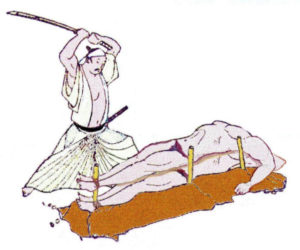
This is the most common region cut for multiple body cutting tests.
This shows example how two bodies were stacked before the cutting test

And the above image depicts the result
Briefly, the koshirae: mounted on tsunagi is in a deep blue sea theme with dark blue silk laced handle & a black-blue lacquer saya done in ishimeji style (imitations of stone). There is a gold shitodome on kurikata and kashira. The habaki is a tomoyasuri gold foil. The seppa are in a gold foil.
The tsuba: Ami-sukashi gunkai no zu tsuba (??????) – Tsuba with openwork design of net and depicting groups of crabs. Mei: Echizen Fukui – Shichir? saku (????????) “Made by Shichir? from Fukui in Echizen”. Tatemaru-gata, shakud?, ji-sukashi openwork design, takabori relief, gold iroe accents, raised dote-mimi with nanako ground. Prior owners’ description follows in quotations.” A tsuba like this one is a rare pleasure. It is a great work of his with a shakudo nanako rim covered with gold and shakudo crabs. The interior of the tsuba is an intricately carved fishing net. The tsuba quality and feeling of this tsuba is ko-kinko. “
The menuki: depicting two crabs each. They are attributed to [Got?]* Kenj? (??), they are Shakud?, katachibori crabs. *The Got? attribution is not spelt out on the Hozon certificate; however sometimes the NBTHK omits the family name if the artist’s name is very distinctive, like in this case with the Got? Kenj? crab menuki. Also another way the NBTHK does it, is by example, just S?min for Yokoya S?min.
Reference from chapter 2.7 Got? Kenj? (????), 7th gen. in the book by Markus Sesko, The Japanese t?s?-kink? Schools: Kenj?´s civilian names were Masatsugu“ (??), „Mitsuha“ (??) and „Mitsutsune“ (??) and his first names were „Gen´ichir?“ (???) and „Ribei“ (???). He was born in the 14th year of Tensh? (1586), the second son of Tokuj?. After the relatively early death of his older brother Eij? he succeeded as head of the family and as the 7th gen. mainline. Together with his cousin Kakuj? (??) he worked on a biennial basis alternating between Ky?to, for the bakufu, and Kanazawa (??) for the Maeda family (??) who were the daimy? of Kaga province. Kenj? died on the 22nd day of the first month of Kanbun three (1663), at the age of 78.
The fuchigashira: signed Kikuchi Tsuneoki + ka? (????????). Tsuneoki was the second master of the Kikuchi lineage. Well-made Shibuichi, sukidashibori relief, spray in gold inlay, iroe accents.
Reference from 24.2 Kikuchi Tsuneoki (????), 2nd gen.,. in the book by Markus Sesko, The Japanese t?s?-kink? Schools: Tsuneoki was the son of Tsunekatsu and followed him as 2nd gen. of the Kikuchi family. Some sources list the later mentioned Tsunemitsu (??) as 2nd gen. but the „S?ken-kish?“, which was published during his lifetime, says that he was a student of Tsunekatsu. That means this information should be correct. However, the „T?s?-kod?gu-k?za“ lists Tsunemitsu as a student and later adopted son and successor of Tsunekatsu. But Tsuneoki´s first name was „Seijir?“ (???) which is seen by some as support of him as having been the 2nd gen. Kikuchi.
Tsuneoki signed first with Masamitsu (??) and later also with Masakatsu (??) but it is not yet completely clarified if Kikuchi Masakatsu was a different kink? than Tsuneoki. The „T?s?-kod?gu-k?za“ even assumes that Masakatsu was the younger brother of Tsunekatsu and had therefore nothing to do with Tsuneoki. Anyway, Tsuneoki is said to have been the student of Inagawa Naokatsu. He used the g? „S?ju“ (??) and „S?juken“ (???) but more details about his career or his year of birth and death are largely unknown.
The tsuka: a dark blue silk lacing, beneath is samegawa nuri (rayskin lacquered black) a very desirable method that highlights the crab menuki well.
Blades certificates images and translation:
NBTHK Tokubetsu Hozon certificate and translation.
Kantei-Sho (???) – Appraisal
No 1001464
Wakizashi , signed: Ichimonji Dewa no Kami Yukihiro (1 st gen.) (????????????)
Kinz?gan-mei : Kanbun yonen hachigatsu nij?hachinichi – Yamano Ka’emon rokuj?nana-sai Nagahisa + ka? – Futatsu-d? mitsu-d? setsudan (???????????????????????????????????) – “Yamano Ka’emon Nagahisa cut [with this blade] on the 28 th day of the eighth month of Kanbun four (1664), and at the age of 67, through two and through three bodies”
nagasa ~ 55.7 cm
According to the result of the shinsa committee of our society, we judge this work as authentic and rank it as Tokubetsu-Hozon T?ken .
August 15, 2013
[Foundation] Nihon Bijutsu T?ken Hozon Ky?kai, NBTHK (??????????)
NTHK npo certificate, worksheet & translation.
kantei-sho ( ??? ) – Certificate
wakizashi (??)
Hizen, Shodai Dewa no Kami Yukihiro (??????????)
shôshin (??) – Authentic
nagasa 1 shaku 8 sun 4 bu kore ari (??????????) – Blade length ~ 55.7 cm
Heisei 28 nen 2 gatsu 26 nichi (????????????) – February 26 th 2016
Non Profit Organization (?????????)
Nihon Tôken Hozon Kai (???????) – NTHK
Board Chairman (???): Miyano Teiji (????)
No T. 160089
meibun (??) – Signature: Ichimonji Dewa no Kami Yukihiro (????????)
kinzôgan-mei : Kanbun yonen hachigatsu nijûhachinichi (??????????,
“28 th day of the fourth month Kanbun four [1664]”) Yamano Ka’emon rokujûnanasai Nagahisa + kaô (????????????, “Yamano Ka’emon Nagahisa, age 67 + kaô ”)
Futatsu-dô mitsu-dô setsudan (????????, “cut through two and three bodies”)
tsukurikomi (????) – Shape: shinogi-zukuri , iori-mune
kitae (?) – Forging: fine ko-itame
hamon (??) – Hardening: flamboyant ô-gunome-midare that varies in width and that is
mixed with tama and tobiyaki
bôshi (??) – Hardening in tip: sugu with a ko-maru-kaeri that runs back to about the height of
the yokote
chôkoku (??) – Engravings:
nakago (??) – Tang: mekugi-ana (???) 1, yasurime (?): ô-sujikai
bikô (??) – Remarks:around Kanbun (1661-1673)
shinsa’in natsu’in (?????) – Seals of Judges: 4 seals
Fittings (Tosogu) certificates images and translation:
NBTHK Hozon certificate and translation.
Kantei-Sho (???) – Appraisal
No 4003643
Ami-sukashi gunkai no zu tsuba ( ?????? ) – Tsuba with openwork design of net and depicting groups of crabs
Mei: Echizen Fukui – Shichir? saku (????????)
“Made by Shichir? from Fukui in Echizen”
Tatemaru-gata , shakud? , ji-sukashi openwork design, takabori relief, gold iroe accents, raised dote-mimi with nanako ground
According to the result of the shinsa committee of our society, we judge this work as authentic and rank it as Hozon T?s?gu .
November 1, 2013
[Foundation] Nihon Bijutsu T?ken Hozon Ky?kai, NBTHK (??????????)
NBTHK Hozon certificate and translation.
Kantei-Sho (???) – Appraisal
No 4008822
Hat? no zu fuchigashira ( ????? ) – Fuchigashira depicting waves
Mei: Kikuchi Tsuneoki + ka? (????????)
Shibuichi , sukidashibori relief, spray in gold inlay, iroe accents
According to the result of the shinsa committee of our society, we judge this work as authentic and rank it as Hozon T?s?gu .
January 15, 2016
[Foundation] Nihon Bijutsu T?ken Hozon Ky?kai, NBTHK (??????????)
NBTHK Hozon certificate and translation.
Kantei-Sho (???) – Appraisal
No 4002773
Nihiki kani no zu menuki (??????) – Menuki depicting two crabs each
Mumei: Kenj? (??)
Shakud? , katachibori
According to the result of the shinsa committee of our society, we judge this work as authentic and rank it as Hozon T?s?gu .
June 27, 2013
[Foundation] Nihon Bijutsu T?ken Hozon Ky?kai, NBTHK (??????????)
*The Got? attribution is not spelt out above; however sometimes the NBTHK omits the family name if the artist’s name is very distinctive, like Got? Kenj?. For example just S?min for Yokoya S?min.
Gallery of additional images in high resolution
Close-up @ 150%
Close-up @ 200%
Following are macro HR detail shots @150%
This Sword is available for purchase. With serious interest please inquire for price.
If you wish to purchase contact us directly via email or contact us at 1(608) 315-0083 any time.
Pictures and content may not be copied without the express permission of samuraisword.com ©










